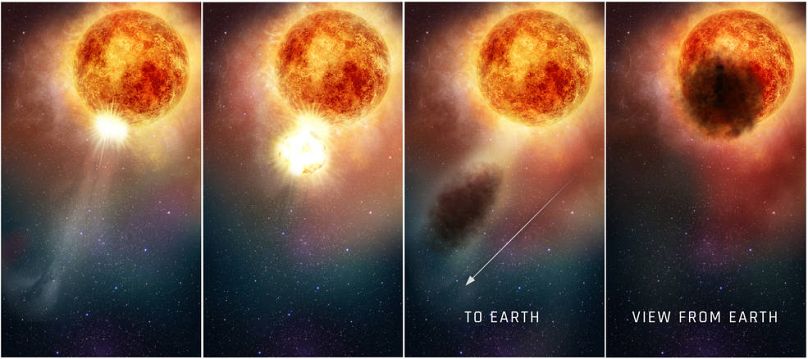The mysterious dimming of one of the brightest stars in the sky, which caused a stir among space-watchers at the end of 2019, may now have an explanation.
The mysterious dimming of one of the brightest stars in the sky, which caused a stir among space-watchers at the end of 2019, may now have an explanation.
Betelgeuse, which lies some 725 light years from Earth, started dimming dramatically in October 2019, losing around two-thirds of its brilliance.
This led some astronomers to speculate the red supergiant - 1000 times the size of the Sun - could be getting close to ending its life in a supernova explosion.
However new evidence suggests such a spectacular event may not be on the horizon just yet. Observations by NASA’s Hubble Space Telescope show the loss of light from the star was most likely due to a huge dust cloud, formed by an expulsion of material from the star.
Researchers suggest the dust cloud formed when superhot plasma released from the star passed through to the colder outer layers, where it cooled and formed dust grains.
This dust cloud blocked the view of the star from Earth, affecting around a quarter of the star’s surface in late 2019. By April 2020 it had returned to normal brightness.
The events on Betelgeuse witnessed by telescopes actually took place around the year 1300, as due to the star’s distance from us, the light is only just reaching Earth now. This means the light is coming to us from a time just before the Black Death became deadliest pandemic in recorded history.
Hubble captured signs of dense, heated material moving through the star's atmosphere in September, October, and November 2019. Then, in December, several ground-based telescopes observed the star decreasing in brightness in its southern hemisphere.
“With Hubble, we see the material as it left the star’s visible surface and moved out through the atmosphere, before the dust formed that caused the star to appear to dim,” said Andrea Dupree, associate director of the Center for Astrophysics.
“We could see the effect of a dense, hot region in the southeast part of the star moving outward.
“This material was two to four times more luminous than the star's normal brightness. And then, about a month later, the south part of Betelgeuse dimmed conspicuously as the star grew fainter. We think it is possible that a dark cloud resulted from the outflow that Hubble detected. Only Hubble gives us this evidence that led up to the dimming."
Scientists expect Betelgeuse to end its life in a supernova, but the events leading up to this explosion have never been observed, explained Dupree.
“Astronomers have sampled stars maybe a year ahead of them going supernova, but not within days or weeks before it happened. But the chance of the star going supernova anytime soon is pretty small,” she added.












